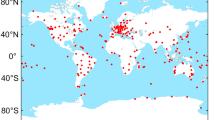Abstract
We propose a method to improve the state estimation accuracy of mobile robots placed near high-rise buildings using the statistical property of the reflected and diffracted waves of global positioning system (GPS) signals. First, it is assumed that a GPS signal that contains a reflected and diffracted wave is denoted by the sum of the true position information and noise that follows a time-varying Gaussian distribution. On the basis of this assumption, the time-varying bias of a GPS signal is tracked using a Kalman filter. In addition, a particle filter, which executes sampling and likelihood evaluation using the estimated bias, is developed. With the proposed method, a GPS signal that contains the rejected noise introduced by the conventional method can be used efficiently, and the state estimation accuracy of the robot in a shadow area of GPS satellite can be improved. Furthermore, a control system for an autonomous mobile robot incorporating the proposed state estimation mechanism is developed, and its effectiveness is evaluated via simulation.









Similar content being viewed by others
References
Hofmann-Wellenhof B, Lichtenegger H, Collins J (2001) GPS: theory and practice, 5th revised edn. Springer, NewYork, pp 125–129
Yamazaki M, Takeuchi E, Ohono K, Tadokoro S (2011) GPS based particle filter localization method with multipath model using 3D-Map. JRSJ 29(8):702–709
Thrun S, Burgard W, Fox D (2005) Probabilistic robotics. MIT Press, Cambridge, pp 117–234
Maier D, Kleiner A (2010) Improved GPS sensor model for mobile robots in urban terrain. In: International conference on robotics and automation
Bekey GA (2005) Autonomous robots: from biological inspiration to implementation and control. MIT Press, Cambridge, pp 57–71
Kitagawa G (1998) Monte Carlo filter and smoother for non-Gaussian nonlinear state space models. J Comput Graph Stat 5:1–25
Doucet A, Freitas N, Gordon N (eds) (2001) Sequential Monte Carlo methods in practice. Springer, Berlin
Tomono M (2011) Probabilistic approaches to localization and mapping for mobile robots. JRSJ 29(5):423–426
Corke P (2011) Robotics, vision and control fundamental algorithms in MATLAB. Springer, Berlin, pp 65–130
Liu JS, Chen R (1998) Sequential Monte Carlo methods for dynamic systems. J Am Stat Assoc 93(443):1032–1044
Author information
Authors and Affiliations
Corresponding author
About this article
Cite this article
Nishida, T., Inoue, S. & Sagara, S. State estimation of mobile robot using GPS signal that includes reflected and diffracted waves. Artif Life Robotics 18, 178–186 (2013). https://doi.org/10.1007/s10015-013-0115-z
Received:
Accepted:
Published:
Issue Date:
DOI: https://doi.org/10.1007/s10015-013-0115-z




